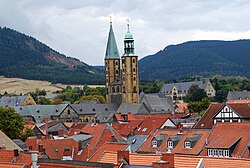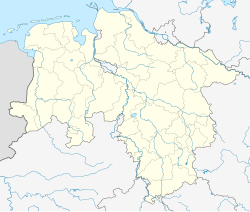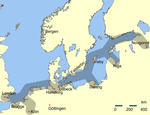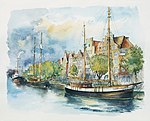Goslar
Goslar | |
|---|---|
Top: Rammelsberg Middle: City centre. Bottom: Kaiserpfalz | |
Location of Goslar within Goslar district <imagemap>File: Goslar in GS.svg | 240x240px poly 871 924 852 907 861 873 872 806 877 822 874 860 895 864 924 855 945 857 943 873 929 906 897 925 887 904 874 922 Clausthal-Zellerfeld poly 995 1161 1001 1247 1029 1243 1027 1215 1093 1203 1111 1176 1097 1153 1063 1144 1071 1113 1051 1112 1045 1131 1003 1113 1013 1145 Braunlage poly 546 817 520 812 522 796 535 796 530 769 547 751 578 759 593 765 590 797 559 806 Clausthal-Zellerfeld poly 597 995 584 887 548 857 551 851 599 866 623 790 706 764 710 718 720 723 719 747 740 752 736 788 721 803 729 851 757 848 776 873 776 901 758 913 723 957 696 989 669 973 Clausthal-Zellerfeld poly 152 319 354 342 337 359 372 387 373 381 371 403 328 422 356 444 386 427 396 454 415 479 390 522 392 573 420 596 410 608 357 588 362 605 387 754 364 750 378 786 360 800 373 830 341 839 318 823 349 762 341 742 261 769 186 741 181 714 211 712 215 607 171 598 186 519 104 442 137 408 117 386 Seesen poly 613 306 703 258 706 270 750 261 740 316 774 319 825 358 844 352 852 322 906 316 931 329 934 308 964 255 986 242 974 188 1014 143 948 42 899 21 821 111 685 145 657 158 627 210 636 215 Liebenburg poly 380 190 407 173 444 173 458 180 485 163 512 155 549 124 574 106 615 101 664 114 664 128 637 141 662 158 642 163 613 207 635 212 615 232 625 249 610 261 620 285 610 290 613 305 664 256 672 273 689 263 689 246 711 268 731 263 750 256 753 278 743 310 726 332 701 347 709 379 743 396 745 418 763 413 772 435 772 450 792 474 760 504 770 555 745 582 721 587 711 541 738 487 709 487 684 467 652 499 664 519 655 550 637 550 625 536 608 541 603 553 576 533 586 519 571 511 549 526 554 563 574 573 571 607 586 609 591 627 606 631 588 646 610 673 564 663 542 678 547 695 537 698 525 671 544 658 542 636 530 627 539 604 549 580 542 573 532 511 552 494 593 484 608 474 628 433 618 420 606 418 593 403 593 386 581 381 552 381 525 369 500 369 456 391 463 408 419 420 399 443 395 420 350 447 333 430 348 418 380 413 380 389 382 369 360 381 341 362 370 357 377 327 392 327 402 315 397 295 387 276 385 239 395 214 Langelsheim poly 674 645 621 686 632 713 677 718 718 699 734 695 743 711 857 668 877 632 907 668 980 559 1009 561 1010 550 993 530 1012 476 999 472 1002 431 984 425 951 397 935 418 917 392 927 350 949 355 944 334 935 323 846 326 848 352 816 360 761 320 724 325 701 363 765 414 779 452 788 482 757 518 768 563 723 599 712 616 728 630 689 658 674 648 630 684 Goslar poly 974 235 935 321 952 357 921 366 935 397 976 405 1012 432 1030 425 1057 448 1071 425 1089 433 1102 457 1138 457 1187 465 1201 495 1256 509 1247 561 1240 580 1266 578 1276 498 1239 478 1268 393 1337 358 1324 349 1269 362 1258 328 1231 319 1236 287 1203 293 1142 198 1138 231 1088 265 1091 314 1021 282 1007 247 Goslar poly 1346 1277 1303 1277 1298 1296 1311 1339 1320 1359 1302 1384 1314 1393 1329 1387 1385 1381 1380 1358 1346 1339 Braunlage poly 1207 1007 1206 1058 1223 1086 1200 1108 1186 1117 1189 1147 1221 1169 1234 1178 1214 1186 1189 1172 1200 1189 1217 1200 1224 1189 1242 1188 1246 1195 1254 1182 1271 1179 1267 1191 1258 1204 1243 1218 1254 1230 1277 1237 1297 1243 1318 1233 1338 1234 1350 1235 1358 1220 1358 1200 1334 1177 1312 1163 1295 1143 1276 1095 1275 1055 1268 1030 1222 1014 Braunlage poly 1002 441 993 472 1022 479 996 530 1020 571 1071 594 1097 625 1136 631 1114 707 1097 726 1063 747 1065 756 1108 722 1119 779 1131 806 1168 811 1161 754 1208 701 1228 707 1255 654 1288 639 1320 577 1329 519 1313 505 1284 495 1265 588 1231 580 1240 513 1189 495 1179 469 1107 465 1073 430 1051 444 1026 421 Bad Harzburg poly 541 570 547 587 539 620 529 641 547 658 533 676 524 685 554 672 566 664 595 668 602 668 592 637 592 622 577 606 565 586 557 565 581 484 538 506 530 552 Langelsheim poly 839 749 853 777 851 788 871 778 888 760 889 745 841 749 Clausthal-Zellerfeld rect 318 1295 380 1361 Goslar (district) rect 25 1042 452 1440 Lower Saxony poly 387 187 569 100 573 38 693 43 699 1 394 3 Wolfenbüttel (district) poly 585 43 696 44 703 2 963 1 995 8 993 31 972 47 956 49 905 16 886 30 860 53 815 92 764 118 682 149 663 116 593 93 579 77 Salzgitter poly 1004 1 986 47 960 55 985 109 1017 127 1031 144 997 185 994 222 1018 244 1030 270 1062 290 1119 220 1143 173 1192 173 1218 156 1235 176 1278 184 1335 121 1326 65 1456 33 1436 4 Wolfenbüttel (district) poly 3 402 38 380 92 430 135 318 207 323 250 307 273 333 371 334 386 314 381 8 8 2 Hildesheim (district) poly 1 405 32 390 182 520 154 607 191 620 164 744 246 768 231 864 289 907 279 1000 289 1041 1 1045 Northeim (district) poly 528 962 524 907 497 893 504 820 447 771 428 814 400 830 382 800 372 805 376 839 334 847 314 846 293 889 311 952 296 1011 296 1038 455 1043 457 1439 486 1454 495 1463 1370 1465 1387 1455 1388 1441 1360 1433 1344 1417 1316 1426 1302 1412 1294 1399 1263 1344 1244 1361 1219 1352 1206 1308 1110 1322 1052 1324 1015 1362 977 1258 913 1230 954 1202 923 1172 976 1157 969 1122 979 1116 964 1092 947 1077 954 1058 990 1003 907 1000 871 978 840 985 814 957 774 923 756 924 712 997 597 1004 573 964 534 970 Göttingen (district) poly 1397 1465 1392 1430 1457 1409 1457 1465 Thuringia poly 1457 1404 1410 1419 1384 1361 1353 1332 1369 1216 1358 1181 1308 1141 1280 1027 1198 991 1176 944 1214 936 1183 795 1224 768 1184 733 1198 715 1247 713 1263 666 1303 657 1352 581 1338 505 1261 477 1281 401 1352 371 1322 335 1281 342 1273 308 1251 306 1246 285 1200 283 1145 191 1227 181 1284 188 1342 116 1335 66 1454 44 Saxony-Anhalt rect 0 0 2000 2000 gemeindefreies Gebiet Harz desc bottom-right </imagemap> | |
| Coordinates: 51°54′26″N 10°25′48″E / 51.90722°N 10.43000°E | |
| Country | Germany |
| State | Lower Saxony |
| District | Goslar |
| Subdivisions | 18 districts |
| Government | |
| • Lord mayor (2021–26) | Urte Schwerdtner[1] (SPD) |
| Area | |
| • Total | 163.71 km2 (63.21 sq mi) |
| Elevation | 255 m (837 ft) |
| Population (2022-12-31)[2] | |
| • Total | 50,203 |
| • Density | 310/km2 (790/sq mi) |
| Time zone | UTC+01:00 (CET) |
| • Summer (DST) | UTC+02:00 (CEST) |
| Postal codes | 38640, 38642, 38644 |
| Dialling codes | 05321, 05325 |
| Vehicle registration | GS |
| Website | www.goslar.de |
| UNESCO World Heritage Site | |
|---|---|
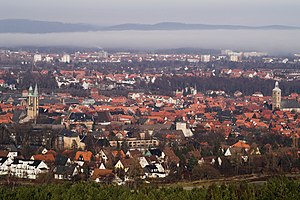 View to the North with the Hildesheim downs in the background. Photograph taken from the Maltermeister Tower | |
| Part of | Mines of Rammelsberg, Historic Town of Goslar and Upper Harz Water Management System |
| Criteria | Cultural: i, iv |
| Reference | 623-001 |
| Inscription | 1992 (16th Session) |
| Extensions | 2010 |
| Area | 363.3 ha |
| Buffer zone | 376.1 ha |
Goslar (German pronunciation: [ˈɡɔslaʁ]; Eastphalian: Goslär) is a historic town in Lower Saxony, Germany. It is the administrative centre of the district of Goslar and is located on the northwestern slopes of the Harz mountain range. The Old Town of Goslar with over 1.500[3] timber houses and the Mines of Rammelsberg are UNESCO World Heritage Sites for their millennium-long testimony to the history of ore mining and their political importance for the Holy Roman Empire and Hanseatic League.[4] Each year Goslar awards the Kaiserring to an international artist, called the "Nobel Prize" of the art world.[5]
Geography
Goslar is situated in the middle of the upper half of Germany, about 40 kilometres (25 miles) south of Brunswick and about 70 km (43 mi) southeast of the state capital, Hanover. The Schalke mountain is the highest elevation within the municipal boundaries at 762 metres (2,500 feet). The lowest point of 175 m (574 ft) is near the Oker river. Geographically, Goslar forms the boundary between the Hildesheim Börde which is part of the Northern German Plain, and the Harz range, which is the highest, northernmost extension of Germany's Central Uplands. The Hildesheim Börde is characterised by plains with rich clay soils – used agriculturally for sugar beet farming – interlaced with several hill ranges commonly known as the Hildesheim Forest and Salzgitter Hills. In the northeast the Harly Forest stretches down to the River Oker, in the east, Goslar borders on the German state of Saxony-Anhalt.
Immediately to the south the Harz range rises above the historic borough at a height of 636 m (2,087 ft) at Mt Rammelsberg. Extended forests dominate the landscape. The major rivers crossing the municipal boundaries are the Oker with its Gose/Abzucht and Radau tributaries. The eponymic River Gose originates approximately 9 kilometres (6 miles) south-west of Goslar at the Auerhahn Pass (638 m (2,093 ft)) east of the Bocksberg mountain. At the northern foot of the Herzberg (632 m (2,073 ft)) it meets the smaller Abzucht before it flows into the Oker. The Dörpke and Gelmke also flow from the Harz foothills to the south into the Goslar municipal area, where they discharge into the Abzucht.
Neighbouring municipalities
(Clockwise from the north): Liebenburg, Schladen-Werla (Wolfenbüttel District), Osterwieck (Harz District, Saxony-Anhalt), Bad Harzburg, Clausthal-Zellerfeld (Oberharz), and Langelsheim.
Town districts
The town currently consists of 18 districts (Stadtteile):
|
Incorporated in 1972:
Incorporated in 2014:
|
Climate
| Climate data for Goslar, Niedersachsen | |||||||||||||
|---|---|---|---|---|---|---|---|---|---|---|---|---|---|
| Month | Jan | Feb | Mar | Apr | May | Jun | Jul | Aug | Sep | Oct | Nov | Dec | Year |
| Mean daily maximum °C (°F) | 2 (36) |
2 (36) |
7 (45) |
10 (50) |
16 (61) |
18 (64) |
21 (70) |
21 (70) |
17 (63) |
13 (55) |
7 (45) |
4 (39) |
11.5 (52.7) |
| Mean daily minimum °C (°F) | −2 (28) |
−3 (27) |
1 (34) |
3 (37) |
7 (45) |
11 (52) |
12 (54) |
12 (54) |
10 (50) |
6 (43) |
2 (36) |
0 (32) |
4.9 (40.8) |
| Source: World Weather Online[6] | |||||||||||||
History
This section relies largely or entirely on a single source. (July 2022) |

Iron ore mining has been common in the Harz region since Roman times; the earliest known evidence for quarrying and smelting is from the 3rd century AD. Ancient burial objects made of Harz ore have even been discovered during excavations in England. The settlement on the Gose creek was first mentioned in a 979 deed issued by Emperor Otto II; it was located in the Saxon homelands of the Ottonian dynasty and probably a royal palace (Königspfalz) already existed at the site. It became even more important when extensive silver deposits were discovered at the nearby Rammelsberg, today a mining museum. The name's toponymy probably comes shortened from "Goselager", of the stream "Gose" on the northern edge of the Harz Mountains, and Lager.
When Otto's descendant Henry II began to convene Imperial synods at the Goslar palace in 1009, Goslar gradually replaced the Royal palace of Werla as a central place of assembly in the Saxon lands, a development that was again enforced by the Salian (Franconian) emperors. Conrad II, once elected King of the Romans, celebrated Christmas 1024 in Goslar and had the foundations laid for the new Imperial Palace (Kaiserpfalz Goslar) the next year.
Goslar became the favourite residence of Conrad's son Henry III, who stayed at the palace about twenty times. Here he received King Peter of Hungary as well as the emissaries of Prince Yaroslav of Kiev and here he appointed bishops and dukes. His son and successor Henry IV was born here on 11 November 1050. Henry also had Goslar Cathedral erected and consecrated by Archbishop Herman of Cologne in 1051. Shortly before his death in 1056 Emperor Henry III met Pope Victor II in the church, emphasizing the union of secular and ecclesiastical power. His heart was buried in Goslar, his body in the Salian family vault in Speyer Cathedral. Of the cathedral only the northern porch survived; the main building was torn down in the early 19th century.
Under Henry IV Goslar remained a centre of Imperial rule. However conflicts intensified such as in the violent Precedence Dispute at Pentecost 1063. While Henry aimed at securing the enormous wealth deriving from the Rammlesberg silver mines as a royal demesne, the dissatisfaction of local nobles escalated with the Saxon revolt 1073–1075. In the subsequent Saxon revolt of 1077–1088 the Goslar citizens sided with anti-king Rudolf of Rheinfelden, who held a princely assembly here in 1077, and with Hermann of Salm, who was crowned king in Goslar by Archbishop Siegfried of Mainz on 26 December 1081, giving Goslar the status of an Imperial City.
In Spring 1105 Henry V convened the Saxon estates at Goslar to gain support for the deposition of his father, Henry IV. Elected king in the following year, he held six Imperial Diets at the Goslar Palace during his rule. The tradition was adopted by his successor Lothair II and even by the Hohenstaufen rulers Conrad III and Frederick Barbarossa. After his election in 1152, King Frederick appointed the Welf duke Henry the Lion Imperial Vogt (bailiff) of the Goslar mines; nevertheless, the dissatisfied duke besieged the town and at an 1173 meeting in Chiavenna demanded his enfeoffment with the estates in turn for his support on Barbarossa's Italian campaigns. When Henry the Lion was finally declared deposed in 1180, he had the Rammelsberg mines devastated.
Goslar's importance as an Imperial residence began to decline under the rule of Barbarossa's descendants. During the German throne dispute the Welf king Otto IV laid siege to the town in 1198 but had to yield to the forces of his Hohenstaufen rival Philip of Swabia. Goslar was again stormed and plundered by Otto's troops in 1206. Frederick II held the last Imperial Diet here; with the Great Interregnum upon his death in 1250, Goslar's Imperial era ended.
While the Emperors withdraw from Northern Germany, civil liberties in Goslar were strengthened. Market rights date back to 1025 and a municipal council (Rat) was first mentioned in 1219. The citizens strove for control of the Rammelsberg silver mines and in 1267 joined the Hanseatic League. Besides mining in the Upper Harz, commerce and trade in Gose beer, later also slate and vitriol, became important. By 1290 the council had obtained Vogt rights, confirming Goslar's status as a free imperial city. In 1340 its citizens were vested with Heerschild rights by Emperor Louis the Bavarian. The Goslar town law set an example for numerous other municipalities, like the Goslar mining law codified in 1359.
Early modern times saw both a mining boom and rising conflicts with the Welf Dukes of Brunswick-Lüneburg, mainly with Prince Henry V of Wolfenbüttel who seized the Rammelsberg mines and extended Harz forests in 1527. Though a complaint was successfully lodged with the Reichskammergericht by the Goslar citizens, a subsequent gruelling feud with the duke lasted for decades. Goslar was temporarily placed under Imperial ban, while the Protestant Reformation was introduced in the city by theologian Nicolaus von Amsdorf who issued a first church constitution in 1531. To assert independence, the citizens in 1536 joined the Schmalkaldic League against the Catholic policies of the Habsburg emperor Charles V. The Schmalkaldic forces indeed occupied the Wolfenbüttel lands of Henry V, however, when they were defeated by Imperial forces at the 1547 Battle of Mühlberg, the Welf duke continued his reprisals.
In 1577 the Goslar citizens signed the Lutheran Formula of Concord. After years of continued skirmishes, they finally had to grant Duke Henry and his son Julius extensive mining rights which ultimately edged out the city council. Nevertheless, several attempts by the Brunswick dukes to incorporate the Imperial city were rejected. Goslar and its economy was hit hard by the Thirty Years' War, mainly by the Kipper und Wipper financial crisis in the 1620s which led to several revolts and pogroms. Facing renewed aggressions by Duke Christian the Younger of Brunswick, the citizens sought support from the Imperial military leaders Tilly and Wallenstein. The city was occupied by the Swedish forces of King Gustavus Adolphus from 1632 to 1635; in 1642 a peace agreement was reached between Emperor Ferdinand III and the Brunswick duke Augustus the Younger. The hopes of the Goslar citizens to regain the Rammelsberg mines were not fulfilled.
Goslar remained loyal to the Imperial authority, solemnly celebrating each accession of a Holy Roman Emperor. While strongly referring to its great medieval traditions, the city continuously decreased in importance and got into rising indebtedness. When Johann Wolfgang von Goethe stayed at Goslar in 1777, he called it "an Imperial city rotted in and with its privileges". In the winter of 1798, the coldest of the century, the young English poet William Wordsworth stayed in the city. To dispel homesickness he started to write a few verses about his childhood, which would eventually evolve into the masterpiece that was published in 13 volumes after his death as The Prelude.[7]
First administrative reforms were enacted by councillors of the Siemens family. Nevertheless, the status of Imperial immediacy was finally lost, when Goslar was annexed by Prussian forces during the Napoleonic Wars in 1802, confirmed by the German Mediatisation the next year. Under Prussian rule, further reforms were pushed ahead by councillor Christian Wilhelm von Dohm. Temporarily part of the Kingdom of Westphalia upon the Prussian defeat at the 1806 Battle of Jena–Auerstedt, Goslar finally was assigned to the newly established Kingdom of Hanover by resolution of the Vienna Congress. The cathedral was sold and torn down from 1820 to 1822, bitterly mourned by Heinrich Heine in his Harzreise travelogue. Again under Prussian rule after the Austro-Prussian War of 1866, Goslar became a popular retirement residence (Pensionopolis) and a garrison town of the Prussian Army. The Hohenzollern kings and emperors had the Imperial Palace restored, including the mural paintings by Hermann Wislicenus.
After the Nazi seizure of power in 1933 Reichsminister Richard Walther Darré made Goslar the seat of the agricultural Reichsnährstand corporation. In 1936 the city obtained the title of Reichsbauernstadt. In the course of German rearmament a Luftwaffe airbase was built north of the town and several war supplier companies located in the vicinity, including subcamps of the Buchenwald and Neuengamme concentration camps. Nevertheless the historic town escaped strategic bombing during World War II.
Part of the British occupation zone from 1945, Goslar was the site of a displaced persons’ camp. During the Cold War era the city near the inner German border was a major garrison town for the West German army and the border police. After the fall of the Berlin Wall in 1989 the barracks were vacated and a major economic factor was lost. The Rammelberg mines were finally closed in 1988 after more than a thousand years.
In the summer of 2018 a bottled typewritten message dated 26 March 1930 was discovered in the roof of Goslar Cathedral, signed by four roofers, who bemoaned the economic state of the country.[8] The bottle was discovered by a roofer who turned out to be the grandson of one of the signatories, who had been an 18-year-old apprentice in 1930.[8] Goslar's mayor replaced the bottle with a copy of the 1930 message, adding his own confidential message.[8]
Demographics
As of 31 December 2020 there were 50,184 inhabitants in Goslar (including Vienenburg).[9]

|
|
|
|
(count: December 31 of each year)
Politics
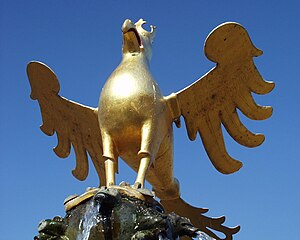

Town council
For the legislature from 1 November 2016 until 31 October 2021 the seats were allocated as follows:
- SPD: 14 seats (37.55%)
- CDU: 10 seats (26.10%)
- AfD: 3 seats (9.28%)
- FDP: 3 seats (6.95%)
- Greens: 3 seats (6.70%)
- Goslarer Linke: 2 seats (5.36%)
- BGL: 2 seats (5.02%)
- AfG: 1 seat (1.69%)
Lord Mayor
Dr Oliver Junk was Mayor from September 2011 to October 2021.[10][11] Since November 2021 Urte Schwerdtner (SPD) has been Mayor of Goslar.[1]
Members of Parliament
- European (Constituency: Southern Lower Saxony), Godelieve Quisthoudt-Rowohl (CDU), Erika Mann (SPD)
- Bundestag (Constituency 52: Goslar, Northeim, Osterode), First: Wilhelm Priesmeier (SPD), List: Hans Georg Faust (CDU)
- Landtag Lower Saxony (Constituency 16: Goslar), First: Petra Emmerich-Kopatsch (SPD), List: Dorothee Prüssner (CDU)
Twin towns – sister cities
Culture and sights
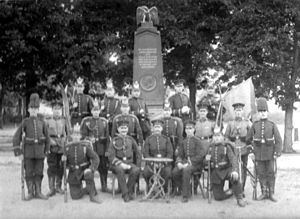



- Memorial to the fallen riflemen of the 10th Hanover Rifle Battalion in the Franco-Prussian War 1870/1871 (now near the Kahnteich)
- Memorial to the fallen riflemen of the 10th Hanover Rifle Battalion in World War I 1914-1918
Theatre
The Odeon Theatre is the town's major theatre. It has been recently refurbished. It is host to several productions of visiting theatre companies and music groups.[citation needed]
The alternative theatre Culture Power Station Harz or Kulturkraftwerk Harz is housed in a disused power station. It is run by volunteers and produces modern theatre, comedy and mostly alternative cultural events. Here the annual Goslar Fringe Culture Days are held during the first half of June.[citation needed]
Museums
- Museum and visitors’ mine Rammelsberg, an Anchor Point of ERIH, The European Route of Industrial Heritage
- Museum in the Kaiserpfalz, a 19th-C reconstruction of the medieval imperial palace
- Monks' House, Mönchehaus Museum of Contemporary and Modern Arts
- Goslar Museum
- Museum in the Gothic Town Hall
- Zwinger Tower and Dungeon, Museum of Late Mediaeval History
Religion


- Protestant-Lutheran
- Congregation Marktkirche, Market Church (build 1151, North Tower mountable)
- Congregation Neuwerk, Newark Church
- Congregation St Stephani, Saint Stephen
- Congregation Zum Frankenberge, Frankenberg Church
- Congregation Gustav-Adolf-Stabkirche, Gustav Adolf stave church in Hahnenklee
- Congregation Martin-Luther-Kirche, Martin Luther Church
- Congregation St Paulus Kirche, St Paul's Church, in Oker
- Congregation St Georg, St George
- Congregation St Johannes, St John
- Parish Church St Kilian in Hahndorf
- Congregation St Lukas, St Luke
- Parish Church St Matthäus, St Matthew, in Jerstedt
- Congregation St Peter
- Baptist
- Congregation Christuskirche, Church of Christ
- Roman Catholic
- Congregation St Jakobi, St James the Greater (built in 1073, Goslar's oldest romanesque church still in use)
- Congregation Maria Schnee, St Mary of the Snows, in Hahnenklee
- Congregation St Barbara (part of St James)
- Congregation St Konrad, St Conrad (part of St James) in Oker
- Congregations Ss Benno & George
- Abbey St George
- Islamic Faith
- Mosque of the Turkish-German Society
- Goslar Mosque
Sports
Situated at the foot of the Harz mountains, Goslar offers a range of outdoor pursuits including swimming, rock climbing, motor sports, flying, sailing and mountain-biking.
The oldest and most traditional sports club is the MTV Goslar (founded in 1849). Its main facilities, a football pitch and gymnasium, are Lon the Golden Meadow (Goldene Aue) site.
The football department of Goslarer SC 08 earned the right to play in the fourth division Regionalliga Nord in 2009-10 after winning the Oberliga Niedersachsen championship.[13]
Celebrations and Events
In 2006 Goslar hosted the Salier Year to celebrate the founding of this ancient German Imperial dynasty a millennium ago.
Other events include:
- Annual award (since 1975) of the ‘Imperial Ring’ to a personality who has made an outstanding contribution to society and the arts. Its recipients include Henry Moore, Joseph Beuys, Christo and Dani Karavan.
- Goslar International Concerto Days, mid to end August
- The Goslar Fair, early to mid July
- Annual Artisans market in the old town, usually beginning of August
- Old Town Festival, mid-September
- Hanseatic Days, Spring (usually during the Easter holidays)
Economy and infrastructure
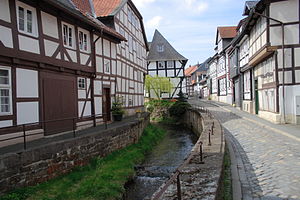

The town centre of Goslar serves as a regional shopping centre for the Northern Harz region. Here department stores, several supermarkets, elegant boutiques and restaurants can be found. Once weekly there is also a market, where farmers sell their local produce. There are also several car dealerships in the borough, some of which specialise in either discount/reimport or custom car sales.
Tourism is a booming sector in Goslar. Several hotels and bed and breakfasts are located in or near the centre of the town. In addition the town has become a popular resort for the elderly and there are many care homes in the town.
Goslar has become a popular conference venue. The Achtermann Hotel and the Kaiserpfalz are popular conference centres, host to the annual German Road & Transport Tribunal Days: the Deutscher Verkehrsgerichtstag
The largest employers in Goslar are H.C. Starck (chemistry company), tourism and the civil service. Many residents of Goslar commute to Salzgitter, where car production, steel works and white-collar jobs are based.
The Dr-Herbert-Nieper-Krankenhaus is a privately owned hospital in the Asklepios Harzkliniken group serving the greater Harz region. A new annex for intensitive medicine is under construction. There are several general practitioners, dentists and specialists distributed across the town. There is an emergency service.
Transport
Goslar has excellent road and rail links to the major European centre of population. Goslar is also a major transport hub for the Upper Harz mountains (highest peak at 1,141 m (3,744 ft) altitude).
With the A 7 and the A 395 there are two main Autobahns/motorways within 20 minutes of Goslar. The A 7 connects Hamburg/Hanover in the North to Frankfurt/Munich in the South. The A 395 branches off the main east-west Autobahn A 2 at Brunswick and ends at Vienenburg, some 12 km (7 mi) east of Goslar. The A 2 connects Berlin – to the East – to the Ruhr Area and the Netherlands in the West. The Federal highways B 6 and B 82 converge at Goslar and are routed via the four-lane by-pass past the town centre. The B 6 is mostly four laned and approaches Goslar via the scenic Hildesheim–Salzgitter route.
Goslar is served by the German Railway network (Deutsche Bahn) lines Hanover–Goslar–Halle (Saxony-Anhalt) as well as Brunswick–Goslar–Kreiensen. The central railway station is near the town centre. There is a park-and-ride system for commuters to Brunswick and Hanover.
At the railway station there is a central bus station with regular bus services to various destinations in the Harz mountains. The buses belong to DB Stadtverkehr.
Media
The regional newspaper is the Goslarsche Zeitung, which has an estimated daily readership of 90,000. The General-Anzeiger is owned by the Heinrich Bauer publishing group with an editorial office in Goslar. There are also two free newspapers..
Radio Okerwelle GoslarRadio is the regional private radio station based in Brunswick, which broadcasts modern music, information and news in German to the Brunswick region.
Education
The three-tier education system in Goslar district falls under Lower-Saxon legislation. The language of instruction at all schools is German. The nine primary schools are distributed across the entire municipality and the associated hamlets. There are two grammar schools (years 5-12/13), the Christian-von-Dohm-Gymnasium and the more traditional Ratsgymnasium, both of which prepare their pupils for an academic career. Three intermediate-level schools (years 5-10), the Andre-Mouton Realschule, the Realschule Hoher Weg and the Realschule Goldene Aue, prepare their pupils for a professional career. There are also two vocational schools (years 5-9/10): the Hauptschule Oker and the Hauptschule Kaiserpfalz. The Sonderschule caters for children with learning difficulties and special needs.
The supplementary public Waldorf school Harz – Branch Goslar educates its pupils along a more spiritual line termed anthroposophy, based on the teachings of the Austrian pedagogue Rudolf Steiner.
For years 10-12 there are four job-training colleges located at Goslar in crafts, economics and care for the elderly for students from Goslar district and beyond. There are two state vocational schools offering part-time education within the German dual vocational education and training system and full-time education.[14] BBS 1 Goslar -Am Stadtgarten- focuses on education in business administration, economics, health services and information and communications technology (ICT).[15] BBS Goslar-Baßgeige/Seesen concentrates on mechanical, electrical and textile engineering; natural sciences: chemistry, physics, biology; food services, domestic science and industry and administration.[16]
The nearest university to Goslar is the venerable old Engineering and Mining School at Clausthal-Zellerfeld in the Upper Harz mountains some 21 kilometres (13 miles) south of Goslar within Goslar district. Some 80 km (50 mi) to the south is the highly acclaimed University of Göttingen (founded by King George II of Great Britain).
Adult education (lifelong learning) for the Goslar area is offered at the Volkshochschule'’.
Notable people



- Frederuna (887–917), queen consort of France by marriage to King Charles III of France.
- Kraft of Meissen (died 1066) provost of Goslarer Dom (Collegiate Church of Goslar), and Bishop of Meissen in 1066.
- Henry IV, Holy Roman Emperor (1050–1106), King of Germany and Holy Roman Emperor.[17]
- Helmold (ca 1120 – after 1177), a Saxon historian of the 12th century and priest.[18]
- Goslar is the ancestral home of the Siemens family since 1384; including the Prussian-British-Russian industrial pioneers Werner von Siemens, Sir William Siemens and Carl von Siemens
- Maurice de Saxe (1696–1750), Marshal General of France. Adversary of the Hanoverians.[19]
- Wilhelm Ripe (1818–1885), painter and graphic designer during the era of Romanticism, died locally
- Albert Niemann (1834–1861), chemist and pharmacist. Credited with the discovery of cocaine
- Otto Wilhelm August Nieper (1848–1939), Chief Surgeon at the hospital in Goslar, which was renamed the Dr.-Herbert-Nieper-Krankenhaus in his honor.
- Ludwig Gattermann (1860–1920), a chemist who worked on organic chemistry and inorganic chemistry.
- Ernst Jünger (1895–1998), German soldier (recipient of the Pour le Mérite decoration in WWI) and author, lived in Goslar from December 1933 to 1936.
- Hans Colbitz (1899–1972), artist, painter, teacher at Albrecht-Duerer-Oberrealschule in Berlin-Neukoelln[20]
- Henning von Tresckow (1901–1944), German military officer and leading anti-Hitler conspirator, was a student at the Goslar Realgymnasium from 1913 until 1917.
- Heinz Günther Guderian (1914–2004), officer in the Wehrmacht and later a Major general
- Rudolf Sprung (1925–2015), politician (CDU), Member of Bundestag 1969–1994
- Dieter Zechlin (1926–2012), pianist
- Rudolf Bindig (born 1940), politician (SPD), Member of Bundestag 1976–2005
- Hermann Max (born 1941), church musician and conductor
- Phylicia Whitney (born 1950), journalist and public speaker
- Ewald Schnug (born 1954), agricultural researcher, professor, Honorary-President of the International Scientific Center for Fertilizers[21]
- Falko Feldmann (born 1959), German biologist and phytomedicologist (Herbal medicine practitioner)
- Sigmar Gabriel (born 1959), politician (SPD), Federal Minister for Foreign Affairs
- Regine Schumann (born 1961), artist, painter and light artist
- Belit Onay (born 1981), politician, Mayor of Hanover since 2019
Sport
- Ernst Pistulla (1906–1944), light heavyweight boxer, silver medallist at the 1928 Summer Olympics
- Günther Brennecke (1927–2014), field hockey player, team bronze medallist at the 1952 Summer Olympics
- Angelika Dünhaupt (born 1946), luger, (rides a sled face-up and feet-first); bronze medallist at the 1968 Winter Olympics
- Carola Hoffmann (born 1962), field hockey player, team silver medallist at the 1988 Summer Olympics
- Mathias Hain (born 1972), football goalkeeper, played 513 games
- Aaron Hunt (born 1986), footballer, played 413 games
References
- ^ 1.0 1.1 "Stichwahlen zu Direktwahlen in Niedersachsen vom 26. September 2021" (PDF). Landesamt für Statistik Niedersachsen. 13 October 2021.
- ^ "LSN-Online Regionaldatenbank, Tabelle A100001G: Fortschreibung des Bevölkerungsstandes, Stand 31. Dezember 2022" (in German). Landesamt für Statistik Niedersachsen.
{{cite web}}: CS1 maint: unrecognized language (link) - ^ "Fachwerkhäuser und prominente Besucher: Goslar ist eine reale Filmkulisse - WELT". DIE WELT (in Deutsch). 2021-05-17. Retrieved 2024-04-19.
- ^ "Mines of Rammelsberg, Historic Town of Goslar and Upper Harz Water Management System". UNESCO World Heritage Centre. United Nations Educational, Scientific, and Cultural Organization. Retrieved 25 Jun 2022.
- ^ "Kaiserring | Mönchehaus Museum Goslar". Retrieved 2020-01-05.
- ^ "Goslar, Niedersachsen Monthly Climate Average, Germany". Archived from the original on January 8, 2019. Retrieved December 18, 2016.
- ^ "In Our Time". BBC Radio 4. Retrieved 5 April 2018.
- ^ 8.0 8.1 8.2 Beck, Luisa (September 19, 2018). "A German roofer working on a cathedral found a message in bottle, written by his grandfather". The Washington Post. Archived from the original on September 20, 2018.
Difficult times of war lie behind us. ... We hope for better times soon to come.
- ^ "Einwohner der Gemeinden und Ortsteile" (PDF). Landkreis - Goslar. Archived from the original (PDF) on 2020-08-01. Retrieved 2019-04-11.
- ^ Bayreuther is OB in Goslar, Frankenpost, 13 November 2011, pg. 2
- ^ Electionresult 2011 in Goslar Archived 2 April 2012 at the Wayback Machine
- ^ "Partnerstädte und Patenschaften". goslar.de (in Deutsch). Goslar. Retrieved 2023-11-20.
- ^ Goslar steigt in die Regionalliga auf – Erlebnisbericht: VfB Oldenburg – Goslarer SC 08 (in German) Game report, accessed: 9 July 2009 Archived June 12, 2009, at the Wayback Machine
- ^ Goslar, Landkreis. "www.landkreis-goslar.de - Schulen". www.landkreis-goslar.de. Retrieved 5 April 2018.
- ^ "About – BBS 1 Goslar -Am Stadtgarten-". www.bbs1goslar.de. Retrieved 5 April 2018.
- ^ "Englisch: Berufsbildende Schulen Goslar-Baßgeige/Seesen". www.bbs-bassgeige.de. Retrieved 5 April 2018.
- ^ Holland, Arthur William (1911). . Encyclopædia Britannica. Vol. 13 (11th ed.). pp. 275–277.
- ^ . Encyclopædia Britannica. Vol. 13 (11th ed.). 1911. p. 249.
- ^ . Encyclopædia Britannica. Vol. 24 (11th ed.). 1911. p. 258-259.
- ^ Research Library for the History of Education, German Institute for International Educational Research, Berlin
- ^ "Staff--International Scientific Center of Fertilizers(CIEC)".
External links
Mines of Rammelsberg, Historic Town of Goslar and Upper Harz Water Management System UNESCO Official Website
- Official website (in English)
- . Encyclopædia Britannica. Vol. 12 (11th ed.). 1911. p. 264-265.
- Goslar at Curlie
- Sound and video of Marktplatz clock
- Pictures of Goslar (German website)
- CS1 maint: unrecognized language
- CS1 Deutsch-language sources (de)
- Webarchive template wayback links
- Articles with German-language sources (de)
- Wikipedia articles incorporating a citation from the 1911 Encyclopaedia Britannica with Wikisource reference
- Short description with empty Wikidata description
- Coordinates not on Wikidata
- Towns in Lower Saxony
- Pages with German IPA
- Articles needing additional references from July 2022
- Articles with invalid date parameter in template
- All articles needing additional references
- Articles containing German-language text
- Articles with unsourced statements from July 2022
- Commons category link is defined as the pagename
- Goslar
- World Heritage Sites in Germany
- Members of the Hanseatic League
- Landmarks in Germany
- Free imperial cities
- Mining communities in Germany

